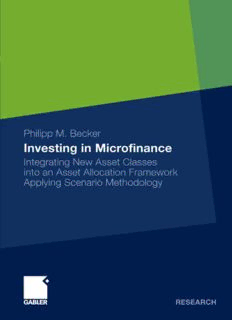Table Of ContentPhilipp M. Becker
Investing in Microfi nance
GABLER RESEARCH
Philipp M. Becker
Investing in Microfi nance
Integrating New Asset Classes
into an Asset Allocation Framework
Applying Scenario Methodology
RESEARCH
Bibliographic information published by the Deutsche Nationalbibliothek
The Deutsche Nationalbibliothek lists this publication in the Deutsche Nationalbibliografi e;
detailed bibliographic data are available in the Internet at http://dnb.d-nb.de.
Doctoral thesis, University of St. Gallen, Switzerland, 2010
1st Edition 2010
All rights reserved
© Gabler Verlag | Springer Fachmedien Wiesbaden GmbH 2010
Editorial Offi ce: Ute Wrasmann | Sabine Schöller
Gabler Verlag is a brand of Springer Fachmedien.
Springer Fachmedien is part of Springer Science+Business Media.
www.gabler.de
No part of this publication may be reproduced, stored in a retrieval system
or transmitted, in any form or by any means, electronic, mechanical, photo-
copying, recording, or otherwise, without the prior written permission of the
copyright holder.
Registered and/or industrial names, trade names, trade descriptions etc. cited in this publica-
tion are part of the law for trade-mark protection and may not be used free in any form or by
any means even if this is not specifi cally marked.
Cover design: KünkelLopka Medienentwicklung, Heidelberg
Printed on acid-free paper
Printed in Germany
ISBN 978-3-8349-2567-1
ACKNOWLEDGEMENTS V
Acknowledgements
An idea that merits examination is a sine qua non for a doctoral thesis. My studies
at the University of St.Gallen and the inspiring atmosphere in the Asset Allocation
& Research department of LGT Capital Management provided me with the roots
and wings to pursue academic merits. In particular, I am very grateful for having
met Professor Pascal Gantenbein, who inspired me at the very beginning of my
academic career and supported my academic development until the very end.
Hence, first and foremost, my deepest gratitude is to Professor Pascal Gantenbein. I
also would like to thank Professor Andreas Grüner for co-supervising this study and
providing thoughtful comments and suggestions.
Furthermore, I am also greatly indebted to Dr. Magnus Pirovino Walter Pfaff and
Dr. Alex Durrer from LGT Capital Management. They create an open platform for
the thoughts of their employees and give advice as well as support whenever needed
for new ideas. One of these ideas – the integration of scenario methodology in asset
allocation – fascinated all of us. Their guidance, enthusiasm and the financial sup-
port enabled this project.
Moreover, I am very grateful to all scenario workshop participants for their es-
sential contributions. Firstly, Professor Minx, Dr. Frank Ruff and Dr. Burkhard
Järisch from Daimler AG, who contributed extensive scenario analysis know-how.
Secondly, with Damian von Stauffenberg, Patrik Huber and Dr. Annette Krauss
three highly regarded microfinance specialists donated some of their valuable time
to give me and all other workshop participants an insight into microfinance. Third-
ly, many more colleagues of LGT Capital Management spent time to create
microfinance scenarios – Johannes Oehri, Hanspeter Oehri, Dr. Matthias Feiler,
Mark Rall, Dr. Marie Mikl, Michael Simmeth, Oliver Karius and Wolfgang Hafen-
mayer. Their input in the scenario workshops are a principal component of my
thesis.
Finally, many close friends and my family supported me during the inspiring but
sometimes difficult times of writing this thesis. Their contribution is invaluable.
Wädenswil, May 2010 Philipp M. Becker
BRIEF CONTENTS VII
Brief Contents
ACKNOWLEDGEMENTS ................................................................................................ V
BRIEF CONTENTS ..................................................................................................... VII
TABLE OF CONTENTS ................................................................................................. IX
ABSTRACT ............................................................................................................... XIII
ZUSAMMENFASSUNG .............................................................................................. XIV
LIST OF FIGURES ...................................................................................................... XV
LIST OF ABBREVIATIONS......................................................................................... XIX
1 INTRODUCTION ................................................................................................. 1
2 ASSET ALLOCATION FRAMEWORK ................................................................... 5
3 SCENARIO APPROACH IN ASSET ALLOCATION ............................................... 24
4 MICROFINANCE ............................................................................................... 46
5 SCENARIO PROCESS MICROFINANCE .............................................................. 81
6 ASSET ALLOCATION MODEL ........................................................................ 119
7 CONCLUSION ................................................................................................. 140
BIBLIOGRAPHY ......................................................................................................... 144
INTERVIEWS ............................................................................................................. 153
APPENDIX ................................................................................................................. 154
TABLE OF CONTENTS IX
Table of Contents
ACKNOWLEDGEMENTS ................................................................................................ V
BRIEF CONTENTS ..................................................................................................... VII
TABLE OF CONTENTS ................................................................................................. IX
ABSTRACT ............................................................................................................... XIII
ZUSAMMENFASSUNG .............................................................................................. XIV
LIST OF FIGURES ...................................................................................................... XV
LIST OF ABBREVIATIONS......................................................................................... XIX
1 INTRODUCTION ................................................................................................. 1
1.1 General motivation ........................................................................................... 1
1.2 Research questions ........................................................................................... 3
1.3 Outline .............................................................................................................. 3
2 ASSET ALLOCATION FRAMEWORK ................................................................... 5
2.1 Asset allocation ................................................................................................ 5
2.2 Portfolio theory ................................................................................................. 8
2.2.1 Mean-variance concept ....................................................................... 9
2.2.2 Shortfall concept ............................................................................... 12
2.3 Investors’ utility preference and categorization ............................................. 16
2.3.1 Private investors ................................................................................ 17
2.3.2 Institutional investors ........................................................................ 19
2.4 Asset allocation requirements ........................................................................ 21
2.5 Summary ......................................................................................................... 22

